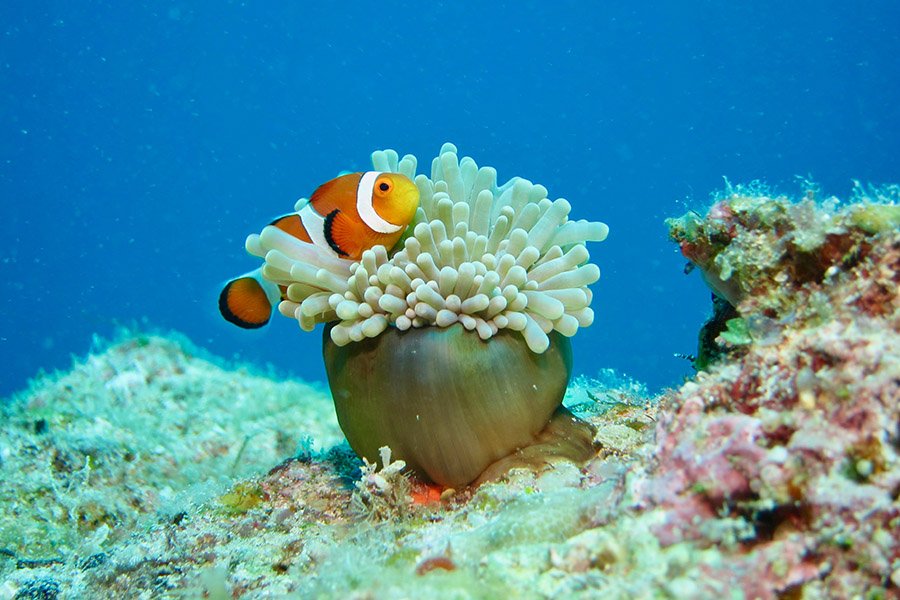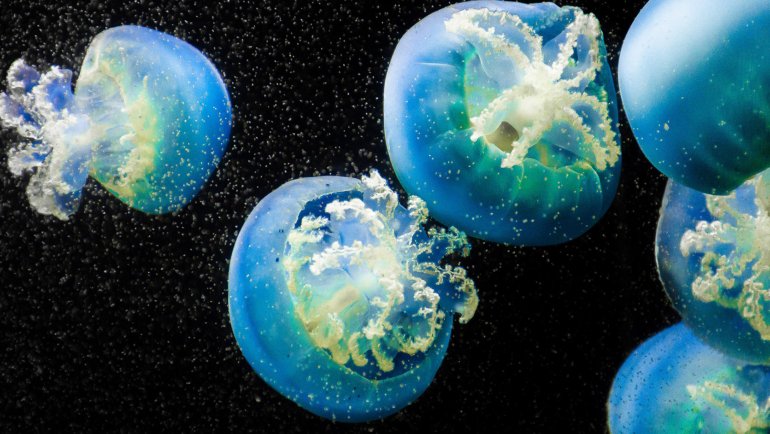Sea anemones, nature’s underwater bouquet, are one of the ocean’s most captivating creatures. With their colorful and graceful appearance, they resemble delicate flowers, yet they are voracious predators with fascinating biology.
This article explores the captivating world of sea anemones, detailing their classification, habitat, behavior, diet, reproduction, and more.
The Sea Anemone at a Glance
Classification
| Kingdom: | Animalia |
| Phylum: | Cnidaria |
| Class: | Anthozoa |
| Order: | Actiniaria |
| Family: | Numerous including Actiniidae, Stichodactylidae |
| Genus: | Numerous genera |
| Species: | Over 1,000 species |
Essential Information
| Average Size: | Varies significantly with different species, from 0.5 inches to 6 feet in diameter (1.27 cm to 1.83 m) |
| Average Weight: | Varies by size and species |
| Average Lifespan: | Many species can live for 50 to 100 years, with some known to live for centuries |
| Geographical Range: | Worldwide, in every ocean |
| Conservation Status: | Not generally considered threatened or endangered, but some local populations may be affected by pollution and climate change. Specific conservation status varies by species. (IUCN Red List) |
Species and Subspecies
With over 1,000 species spread across various families, sea anemones offer remarkable diversity. They range from the tiny intertidal species such as Anthopleura elegantissima, also known as the aggregating anemone, to the massive deep-sea dwelling Stichodactyla gigantea, known as the giant carpet anemone.
Coloration, size, preferred habitat, and the presence or absence of symbiotic relationships with other species are among the distinguishing characteristics of different sea anemone species.

Description
Sea anemones are cylindrical or column-shaped animals that are often brightly colored. They have a flat base used for attachment to surfaces, a cylindrical body, and an array of tentacles surrounding a central mouth at the top of the body.
The size of sea anemones varies considerably with different species, ranging from less than an inch (2.54 cm) in diameter to up to 6 feet (1.83 m) in some giant species.
These creatures exhibit radial symmetry, meaning their body parts are arranged around a central axis in a way that any cut through this axis results in identical halves.
Sea anemones do not show sexual dimorphism as most species are hermaphroditic, having both male and female reproductive organs.
Habitat and Distribution
Sea anemones inhabit a wide range of habitats in every ocean on Earth. They are found from the tidal zone to depths of more than 33,000 feet (10,000 meters). Some species prefer rocky shores, others sandy or muddy bottoms, and some dwell on the deep ocean floor.
They can also be found in kelp forests, seagrass beds, on coral reefs, and some species even associate with other animals such as hermit crabs. Despite their global distribution, the highest diversity of sea anemones is found in coastal tropical regions.

Behavior
Sea anemones generally lead a sessile lifestyle, attaching themselves to submerged rocks, shells, or coral reefs. However, if necessary, they can slowly glide on their base or somersault on their tentacles. They can also detach and float to a new location. Many species are crepuscular, most active during twilight hours of dawn and dusk.
Sea anemones are typically solitary animals but certain species can form colonies by asexual reproduction. They do not have a complex communication system but can react to physical stimuli and the presence of prey or threats in their immediate environment.
Diet and Hunting/Feeding Behavior
Sea anemones are carnivorous. Their diet primarily includes small fish, mussels, plankton, and other small marine organisms. The tentacles of the sea anemone contain stinging cells called cnidocytes, each housing a tiny, harpoon-like structure that can inject venom into prey or potential threats.
When a prey item comes into contact with the tentacles, the anemone fires these microscopic harpoons, paralyzing the prey. The tentacles then transport the prey to the mouth located in the center of the body. Larger species of sea anemones can consume larger prey, even small crabs.
Predators
Despite their venomous cells providing some level of protection, sea anemones do face predation from a number of marine species. Certain species of sea slugs, starfish, eels, flounders, and codfish are known to eat sea anemones.
The loggerhead sea turtle is also a well-known predator. Predators typically manage to eat the sea anemone without triggering the discharge of cnidocytes or are immune to the venom.

Reproduction and Life Cycle
Sea anemones reproduce both sexually and asexually. In sexual reproduction, they release eggs and sperm into the water, where fertilization occurs. The resulting larvae, known as planulae, drift in the ocean before settling down on a suitable substrate and growing into a new sea anemone.
In asexual reproduction, a part of the sea anemone’s body, the pedal disc, divides and each part grows into a separate individual. This is known as fission. Some species can also reproduce through budding, where a small anemone grows out from the body of the parent and eventually detaches.
Sea anemones do not have a specified gestation period, as their reproduction does not involve any form of pregnancy. The care of the young also doesn’t apply as sea anemones are essentially solitary from birth.
Conservation and Threats
The conservation status of sea anemones widely varies as there are over 1000 species, and many are yet to be evaluated for their conservation status. A number of species are listed as “Least Concern” on the IUCN Red List, but data is deficient for many others.
Major threats to sea anemones include pollution, climate change, and habitat destruction, particularly the degradation of coral reefs. Ocean acidification, a result of increased carbon dioxide levels, can also adversely affect sea anemones by reducing their ability to build and maintain their calcium carbonate structures.
Conservation efforts for sea anemones are generally targeted at preserving their habitats. This includes efforts to protect coral reefs and control pollution. Research is ongoing to better understand the biology and ecology of these creatures and inform more effective conservation strategies.
Fun Facts
- Sea anemones are named after the terrestrial flowering plant “anemone” due to their colorful and flower-like appearance.
- They are able to move slowly using their pedal disc (base), either sliding along or somersaulting in a slow and acrobatic display.
- Some sea anemones establish mutualistic relationships with other animals. For example, clownfish are known to live among the tentacles of sea anemones, where they are protected from predators.
- Despite their plant-like appearance, sea anemones are carnivorous and have been known to consume small fish, mussels, and even small crabs.
- Certain species of sea anemone can live for 50 years or more in the wild, and some species like the ‘clone-forming’ anemone are believed to be potentially immortal.
Frequently Asked Questions
Are sea anemones plants or animals?
Despite their plant-like appearance, sea anemones are actually animals. They are a type of marine invertebrate and belong to the phylum Cnidaria, which also includes jellyfish and coral.
How do sea anemones eat?
Sea anemones are predators and catch their prey with their tentacles, which are equipped with stinging cells. They immobilize their prey using these stinging cells and then transport the food into their mouth, located in the center of their body.
Do sea anemones sting humans?
While sea anemones do have stinging cells, most are harmless to humans. However, some larger species can deliver a painful sting.
How do sea anemones reproduce?
Sea anemones can reproduce both sexually and asexually. They can release eggs and sperm into the water for external fertilization or divide their body or bud to produce new individuals.
Do sea anemones have brains?
No, sea anemones do not have brains or centralized nervous systems. Instead, they have a simple nerve net that allows them to respond to their environment.



